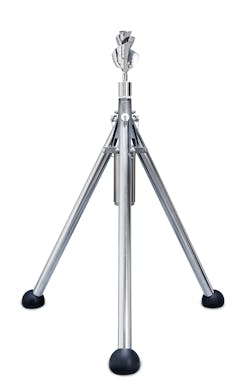Large seasonal variations in drinking water demand can often complicate distribution and treatment operations. Northglenn, Colo., experiences variations in demand ranging from 9.5 MGD in the summer months to 2.0 MGD in winter months, a 400 percent fluctuation. The treatment plant draws raw water from a terminal reservoir and treats it through a series of processes, including flocculation, clarification and mixed media filtration. To optimize plant performance and operating costs, operators strive for relatively constant throughput rates and gradual changes in volume.
In early 2018, operators attended a local educational seminar entitled “Tools for Distribution System Water Quality” to learn about a new suite of technologies for mixing storage tanks. Properly sized tank mixers can “destratify” water storage tanks, completely mixing tanks to create consistent disinfectant residual throughout. Submersible active mixers are powerful enough to fully turn over multi-million-gallon water tanks several times each day. Moreover, they provide a platform for supplemental technologies that can be added to remotely monitor and dose residual, as well as to volatilize disinfectant byproducts such as trihalomethanes (THMs). Together, these technologies allow operators to target individual water storage tanks to regulate residual levels while reducing THM levels across pressure zones.
Given the dramatic increases in temperature and demand for water in summer months, coupled with declining network residual resulting from the higher temperatures, operators at the Northglenn Water Treatment Plant typically increased exit residual targets to about 1.40 mg/L. An unintended consequence of the increased disinfectant was higher levels of THMs at several locations. The utility had an internal THM threshold of 40 ppb, above which additional sampling and testing are required, resulting in increased costs to the city. The challenge for Northglenn operators was to maintain sufficient (and consistent) disinfectant residual levels while avoiding elevated THM levels.
As they compared various technologies to address these issues, operators were pleased to learn they could begin with tank mixing, evaluate those results, and then add additional technology to address specific areas as needed. This incremental approach eliminated the risk that capital would be spent unnecessarily by enabling the city to determine whether mixing alone could improve water quality before spending additional funds. By adding mixing to achieve homogeneous residual levels in its tanks, the city hoped to utilize the incoming residual dose from the treatment plant more efficiently throughout its distribution network. Limiting the amount of chlorine dosed into the distribution network would, in turn, reduce THM levels.
A series of three storage tanks were identified for the installation of submersible active mixers from PAX Water Technologies. The tanks ranged from 2 MG to 3 MG and were hydraulically linked to each other. A single PAX PWM400 Mixer was installed in each tank in October of 2018. The mixers operate with a 0.5 hp motor and an impeller spinning at over 1,000 revolutions per minute (rpm) to create a vortex flow pattern capable of fully mixing the entire volume of water inside the tank several times per day in order to overcome thermal and chemical stratification.
“Since installing the PAX Mixers at three tanks we have been able to lower our chlorine residual from 1.4 to 1.0 mg/L,” Jason Hensel, operations manager with the City of Northglenn said. “Consequently, our THM levels have stayed below our goal of 40 ppb. In addition, operators have commented that they observe the chlorine smell is less pungent and there is no accumulation of condensation inside the tops of the tanks.”
Additionally, the mixers have eliminated thermal and chemical stratification, allowing the utility to use less chlorine, maintain consistent residual and stay below the THM threshold since their installation. Should the time come when the utility needs additional treatment technology, it can easily add on components to provide greater residual control and THM removal. WW
About the Author: Andrew Seidel is the Chief Executive Officer and Chairman of UGSI Solutions, Inc., a process technology company specializing in chemical feed and disinfection. He has recently served as a Director on the Boards of O’Brien & Gere, a private engineering services company located in Syracuse, N.Y., and Ostara Nutrient Recovery Technologies Inc., a resource recovery company located in Vancouver, Canada.
About the Author
Andrew Seidel
Andrew Seidel is the Chief Executive Officer and Chairman of UGSI Solutions, Inc., a process technology company specializing in chemical feed and disinfection. He has recently served as a Director on the Boards of O’Brien & Gere, a private engineering services company located in Syracuse, NY and Ostara Nutrient Recovery Technologies, Inc. a resource recovery company located in Vancouver, Canada.


